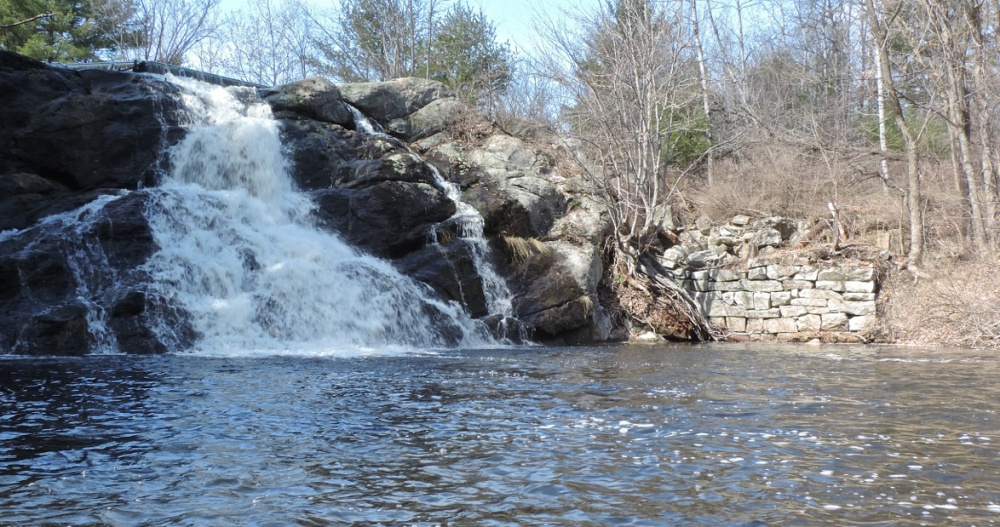April paddling is like the light spray of fizz escaping from a just- opened bottle of ginger ale. It’s tangy air invigorating your face mixing with the warmth of sun soothing your back; pure blue sky providing a canvas for wispy cirrus announcing the approach of tomorrow’s showers; red maple buds ready to burst forth; and a solitary trout fisherman along the shoreline celebrating the emergence of spring by wetting some line. And you are out in the middle of it all in your beloved canoe.
If our first April canoe adventure is any indication of the season to come, we are in for some extraordinary outings.
For our annual inaugural excursion we usually dip the paddles into waters making up the myriad ponds east of Augusta, but this year decided to try something new, in York County. After studying our dog-eared DeLorme Maine Atlas and Gazetteer the night before, a ribbon of blue caught our eye in the Hollis area: the Saco River Reservoir.
When a dam was built at Union Falls, it backed up the Saco River behind it, creating a narrow reservoir that winds nearly four miles up to Hollis Center. The shoreline is thickly forested, with hillsides of hemlock and pine, interspersed with beech and birch. There are few houses along the shoreline, giving the reservoir an authentic feel of wilderness. Judging by the size of the boat launch at Skelton Dam, the reservoir is a busy place in the summer. Go now and have it to yourself. We saw two kayakers on our three hours of exploring the length of the waterway.
A half-mile west of where the Saco River flows into the reservoir from Bar Mills, a large island sits yards from the north shoreline. A 30-foot cliff rises straight up from the water. We inched along it peering up at tenacious small pines leaning out over us and a mosaic of rich stains created from rain water leaching through lichens, mosses and grasses.
Fifty yards beyond the cliff, we found a spot to land and scampered up through the dark hemlock-forested slope to the top of the cliff. The views were dazzling. Early afternoon puffs of clouds spread below us, mirrored in the calm waters. We thought back to times in other wilderness spots gazing out over similar watery expanses to wild lands beyond. Images of the Hoh River Valley in Olympic National Park in Washington came to mind as well as views over Jo-Mary Lake from Potaywadjo Ridge in the 100-Mile Wilderness of the Appalachian Trail.
The reservoir narrows as you near the western end. A conspicuous ledge sticks out into the water on the right, and you will see the purple metal roof of the Hollis Center Baptist Church on Route 202 through the hardwoods. You can follow the trail up the banking and walk the road a quarter-mile into Hollis Center.
At the end of the reservoir a braided waterfall tumbles down over a terrace of ledges 15 feet high. We paddled right to their edge and took numerous photos trying to capture the ceaseless flow of white caressing the contours of the rocks. Granite stones at the water’s edge are remnants of an old sawmill.
The eastern end of the reservoir features tumbling water as well, but much more volume as the spring runoff from the Mt. Washington Valley heads seaward via the Saco River through the spillway of Skelton Dam. This impressive earthen dam, built in 1948, is the largest of the six hydroelectric dams that span the Saco, rising 74 feet above the river below the dam. Skelton Dam features the largest fish lift in Maine, built at a cost of $6 million in 2001.
Consult the DeLorme gazetteer (maps Nos. 2 and 3) for help in getting to the boat launch adjacent to Skelton Dam. You can also launch your canoe at Pleasant Point Park on Simpson Road just south of Route 117. This time of year the gravel access road is gated, so it is a 200-yard carry down to the water through a beautiful pine grove park. We have a light canoe, so we launched there.
We didn’t encounter much wildlife – a few mallards along the shoreline, and pileated woodpecker and crow calls echoing through the woods. You will see more wildlife than we did as the days warm, and the loons, osprey and herons return.
If you have time, stop and check out the displays at the Buxton-Hollis Historical Society located in a stately white schoolhouse at 100 Main St. in Bar Mills. It’s open Saturday mornings from 9 a.m. to noon. Of note: children’s advocate and author of the book “Rebecca of Sunnybrook Farm” Kate Douglas Wiggins lived in a white 1797 home on Salmon Falls Road.
Michael Perry is the former director of the L.L.Bean Outdoor Discovery Schools, and founder of Dreams Unlimited, specializing in inspiring outdoor slide programs for civic groups, businesses, and schools.
Contact: michaelj_perry@comcast.net
Send questions/comments to the editors.



Success. Please wait for the page to reload. If the page does not reload within 5 seconds, please refresh the page.
Enter your email and password to access comments.
Hi, to comment on stories you must . This profile is in addition to your subscription and website login.
Already have a commenting profile? .
Invalid username/password.
Please check your email to confirm and complete your registration.
Only subscribers are eligible to post comments. Please subscribe or login first for digital access. Here’s why.
Use the form below to reset your password. When you've submitted your account email, we will send an email with a reset code.